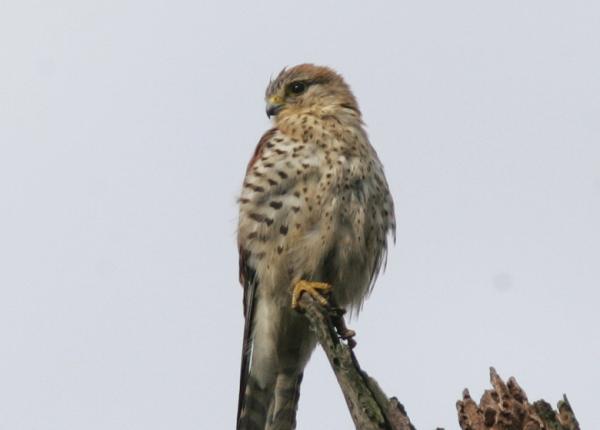Did You Know?
- The Malagasy Kestrel is one of the most common raptors in Madagascar
- This kestrel is believed to be monogamous, meaning that one male and one female remain together as a pair for life
How The Peregrine Fund is Helping
The Peregrine Fund has done some studies on the Malagasy Kestrel. In fact, we have a very strong conservation program in Madagascar. Apart from the studies we conduct on several endemic raptors, we work hand in hand with the locals to help foster conservation on the island. Among our three conservation areas, we have assisted communities in planting more than 215,000 saplings to restore forests and establish plantations for food and jobs. We have fostered a professional staff of more than 30 Malagasy people, many with advanced degrees, who contribute scientific knowledge and lead their communities in conservation.
Additionally, our efforts in scientific research, habitat conservation, education, and community development help conserve birds of prey around the world. We also supply literature to researchers from our avian research library, which helps scientists around the world gather and share important information on raptor conservation.
Where They Live
The Malagasy Kestrel is found on only two islands in the entire world. If you guessed that one of the islands is Madagascar, you are correct. The other island is Aldabra Island, which is part of the Seychelle's Outer islands. It makes its home in a variety of different open habitats such as clearings, grasslands, croplands, and in and around villages. Researchers from The Peregrine Fund believe that this species may actually prefer occupying areas near human homes.
Why They Need our Help
The Malagasy Kestrel is categorized as a species of Least Concern. In fact, researchers believe that populations have likely increased as the result of deforestation, cultivation, and urbanization, which provides them with more habitat.
What They Eat
This kestrel loves to feed on insects. In fact, its favorite food item is grasshoppers. However, it will also hunt small vertebrates such as rodents, birds, lizards, and frogs. René de Roland, a biologist with The Peregrine Fund, discovered that Malagasy Kestrels that live on the Masoala Peninsula feed almost exclusively on plated lizards.
This small raptor employs a few different hunting techniques to catch its prey. It often sits on a perch, waiting for prey to pass by, which it often captures in flight. It might also drop to the ground to capture prey, or it snatches a meal from tree trunks. This species also hovers in search of prey. If you ever visit Madagascar, search for these birds at dawn or dusk, where they can often be seen foraging for food.
Nests, Eggs, and Young
Like other falcons, the Malagasy Kestrel doesn't build its own nest. Instead, it lays its eggs in natural cavities in trees, rocky areas, epiphytes, palm trees, cliffs, or on buildings. It has also been observed nesting in stick nests built by other birds, including Pied Crows or Yellow-billed Kites.
When the time is right, the female will lay between 3-5 eggs, which are a reddish color. These eggs must be incubated for around 28 days. After the nestlings hatch, they will grow very quickly and in a little over three weeks, they are ready to fly from the nest for the first time. After their first flight, the young will remain in their parents' territory for around 44 more days before they disperse and are completely independent.
Malagasy Kestrel and the World Center for Birds of Prey
Though the World Center for Birds of Prey is far away from the Malagasy Kestrel's range, the center still offers fun ways to learn about this raptor, the work we are doing in Madagascar, and other birds of prey. Interactive activities, tours, interesting videos and a children's room with activities from coloring sheets to quizzes to costumes await you. At our visitor center, you can see many hawks up close and learn about the wonderful and interesting adaptations they have in order to survive in their respective habitats.
References:
Global Raptor Information Network. 2022. Species account: Malagasy Kestrel Falco newtoni. Downloaded from http://www.globalraptors.org on 29 Mar. 2022
Kemp, A. C. and G. M. Kirwan (2021). Malagasy Kestrel (Falco newtoni), version 1.1. In Birds of the World (J. del Hoyo, A. Elliott, J. Sargatal, D. A. Christie, and E. de Juana, Editors). Cornell Lab of Ornithology, Ithaca, NY, USA. https://doi.org/10.2173/bow.madkes1.01.1









